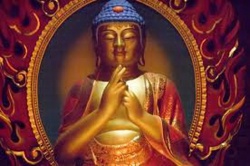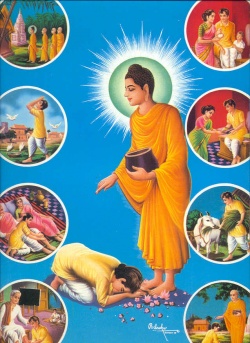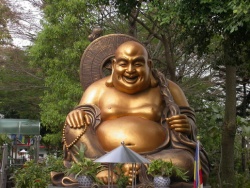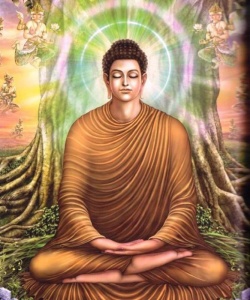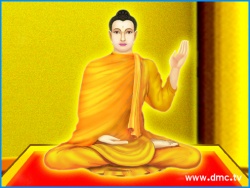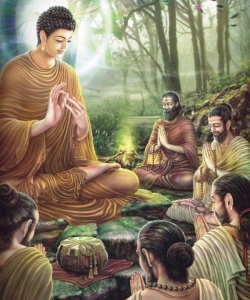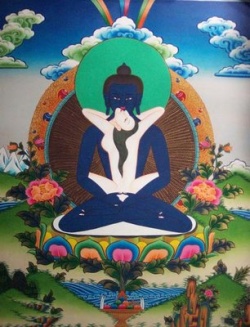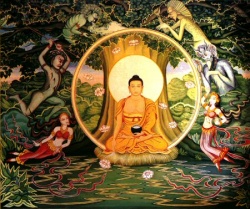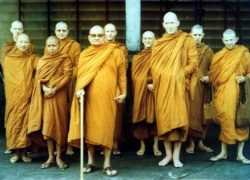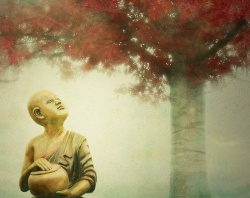Anatta
In Buddhism, the term anattā (Pāli) or Anātman (Sanskrit: अनात्मन्) refers to the notion of "not-self" or the illusion of "self". In the early texts, The Buddha commonly uses the word in the context of teaching that all things perceived by the senses (including the mental sense) are not really "I" or "mine", and for this reason one should not cling to them.
Anatta' means ‘no self’ and the doctrine of anattà is the Buddha’s most unique and radical teaching. We usually assume that beyond our changing body, mind and experience is an unchanging and unique ego or self.
Having identified this self as ‘me’ we then identify other things as ‘mine’ – ‘My spouse’ ‘My property’, ‘My religion’, ‘My country’, etc.
This, according to the Buddha, is the cause of much of the distress and pain humans inflict upon themselves and others through greed, fear, ignorance, hatred and self-deception.
The Buddha says, ‘Body is not self, feelings are not self, perception is not self, mental constructs are not self and consciousness is not self…When one sees this one becomes detached from these things, being detached the passions fade, when the passions have faded one is free, and being free one knows one is free’ (Samyutta Nikaya 3. 66). One sometimes hears it said that the purpose of Buddhism is to destroy the self.
This is not correct simply because there is no self to destroy. The Buddha taught that when the idea of a permanent metaphysical self or soul is seen to be an illusion, then one will cease to suffer and also cease to inflict suffering on others.
The Chariot
The five aggregates acting in unison give the illusion of a self; a perceived self if you will.
Each of the aggregates when examined individually is empty, no essence, no permanence whatsoever.
In the Milindapanha, the arahant Nagasena describes it well with the talk on the chariot and the parts of the chariot.
Nagasena asks if the pole of the chariot is the chariot. Answer, no. Nagasena asks if the axel is the chariot or if the wheels are the chariot.
Answer, no. Nagasena asks if the reins are the chariot. To this and further questions about the parts, the answer is no. Nagasena explains that the chariot is not something other than these parts. Yet the parts are not the chariot. Nagasena states that chariot is just a word, it exists, but only in relation to the parts.
The concept "chariot" does not have an intrinsic, inherent value or place as something permanent. It is the same with the self. We certainly exist, just as a chariot exists, but it is more in terms of conventional language as opposed to absolute language.
Nagasena developed this excellent teaching from the wise words of Venerable Vajjira, a bhikkhuni who lived during the time of the Buddha. She once remarked:
"Just as, with an assemblage of parts, the word chariot is used, so when the aggregates exist, there is the convention of being."
Samyutta Nikaya 5.554
Anatta and Rebirth
When some people learn that Buddhism teaches rebirth and also that there is no self (anattà), they find it difficult to understand how rebirth can take place. ‘If there is no self or soul,’ they ask, ‘what passes from one life to the next?’
This problem is more apparent that real. Firstly, the Buddha did not teach that there is no self per se – he taught that there is no permanent, unchanging metaphysical self.
In Buddhism, as in contemporary psychology, the self is understood as a constantly evolving cluster of impressions, memories, traits and dispositions. It is this ‘self’ that passes from one life to the next. Imagine three billiard balls in a line, each touching the other and a fourth billiard ball some distance from the three and aligned to them.
Now imagine that a man hits the fourth ball with his cue and it speeds across the table and hits the first ball in the line. The moving ball will come to an immediate halt, the first and second balls will remain stationary while the third ball, the last in the row, will speed across the table and into the pocket.
What has happened? The energy in the fourth ball has passed through the first and second balls in the row, into the third ball, animating it so that it moves across the table. In a similar way, the mental energy that makes up our so-called ‘self’ moves from one body to another.
Ven. Dhammika explains this further with the following:
Surely it is correct to say that Rome is 2500 years old despite the fact that the city changes every day. We have no problem at looking at a photo of ourselves taken in childhood and saying "That's me" despite the fact that our size, shape, muscle tone, ideas, opinions, etc have completely changed since the photo was taken.
The individual is like a football team founded 75 years ago. During that time hundreds of players have joined the team, played with it for five or ten years, left and been replaced by other players. Even though not one of the original players is still in the team or even alive, it is still valid to say that 'the team' exists. Its identity is recognizable despite the continual change.
The players are hard, solid entities but what is the team's identity made up of? Its name, memories of its past achievements, the feelings that the players and the supporters have towards it, its esprit de corps, etc.
Individuals are the same. Despite the fact that both body and mind are continually changing, it is still valid to say that the person who is reborn is a continuation of the person who died; not because any unchanging self has passed from one to another but because identity persists in memories, dispositions, traits, mental habits and psychological tendencies.
In the same vein, the Pali suttas (and parallel āgamas, both referred to collectively below as the nikāyas), categorize the phenomena experienced by a being into five groups ("Khandhas") that serve as the objects of clinging and as the basis for a sense of self. In the Nikāyas, The Buddha repeatedly emphasizes not only that the five Khandhas of living beings are "not-self", i.e. not "I" or "mine", but also that clinging to them as if they were "I" or "mine" gives rise to unhappiness.
According to the early texts, while on the path, one should develop oneself in healthy and liberating ways, only letting go of the attempt to improve the self as it becomes unnecessary.
Overview
The anattā doctrine is not a type of materialism. Buddhism does not necessarily deny the existence of mental phenomena (such as feelings, thoughts, and sensations) that are distinct from material phenomena.
Thus, the conventional translation of anattā as "no-soul" can be misleading. If the word "soul" refers to a non-bodily component in a person that can continue in some way after death, then Buddhism does not deny the existence of a soul.
In fact, persons (Pāli: puggala; Sanskrit, pudgala) are said to be characterized by an ever-evolving consciousness (Pali: samvattanika viññana), stream of consciousness (Pali: viññana sotam; Sanskrit: Vijñana srotām), or mind-continuity (Sanskrit: Citta-Saṃtāna) which, upon the death or dissolution of the aggregates (Skandhas), becomes one of the contributing causes for the arising of a new group of Skandhas.
However, Buddhism denies the existence of a permanent or static entity that remains constant behind the changing bodily and non-bodily components of a living being. Reportedly, The Buddha reprimanded a disciple who thought that in the process of Rebirth the same consciousness is reborn without change.
Just as the body changes from moment to moment, so thoughts come and go; and according to the anattā doctrine, there is no permanent conscious substance that experiences these thoughts, as in Cartesianism: rather, conscious thoughts simply arise and perish with no "thinker" behind them. When the body dies, the incorporeal mental processes continue and are reborn in a new body. Because the mental processes are constantly changing, the new being is neither exactly the same as, nor completely different from, the being that died.
On one interpretation, although Buddhism rejects the notion of a permanent self, it does not reject the notion of an empirical self (composed of constantly changing physical and mental phenomena) that can be conveniently referred to with words such as "I", "you", "being", "individual", etc. Early Buddhist scriptures describe an enlightened individual as someone whose changing, empirical self is highly developed.
According to Buddhist teachings, this phenomenon should not, either in whole or in part, be reified, either in affirmation or denial. The Buddha rejected the latter metaphysical assertions as ontological theorizing that binds one to Suffering.
On another interpretation, Buddhism rejects any idea of the self. On this view it is incorrect even to speak about an "empirical self". This is because constantly changing physical and mental phenomena all have impermanence, and anything with such impermanence does not amount to the idea of a self. One is permitted to use terms such as "I", "you", and so on, not because they refer to an empirical self, but simply because they are "convenient designations".
They are used in much the same way that the word "it" is used in the sentence "It is cold". Here there is nothing that the word "it" refers to. It is merely a grammatical device which allows one to assert "there is cold", while using a substantive term.
Some Mahayana Buddhist sutras and tantras present Buddhist teachings on emptiness using positive language by positing the ultimate reality of the "true self" (Atman). In these teachings the word is used to refer to each being's inborn potential to realize Buddhahood through Buddhist practices, and future status as a Buddha. This teaching, which is soteriological rather than theoretical, portrays this potential or aspect as undying.
Anattā, Dukkha (Suffering/unease), and anicca (impermanence), are the three Dharma seals, which, according to Buddhism, characterise all conditioned phenomena.
Anatta in the Nikayas
The Buddhist term anatta (Pāli) or Anātman (Sanskrit) is used in the sutras both as a noun and as a predicative adjective to denote that phenomena are not, or are without, a Self, to describe any and all composite, consubstantial, phenomenal and temporal things, from the macrocosmic to microcosmic, be it matter pertaining to the physical body or the cosmos at large, as well as any and all mental machinations, which are impermanent.
Anatta in Sutra is often used in conjunction with the terms Dukkha (imperfection) and anicca (impermanence), and all three terms are often used in triplet in making a blanket statement as regards any and all compounded phenomena. “All these aggregates are anicca, Dukkha and anatta.”
The one scriptural passage where Gautama is asked by a layperson what the meaning of anatta is as follows:
- Samyutta Nikaya At one time in Savatthi, the Venerable Radha seated himself and asked of the Blessed Lord Buddha: “Anatta, anatta I hear said, Venerable. What, pray tell, does Anatta mean?” “Just this, Radha, form is not the self (anatta), sensations are not the self (anatta), perceptions are not the self (anatta), assemblages are not the self (anatta), consciousness is not the self (anatta). Seeing thusly, this is the end of birth, the Brahman life has been fulfilled, what must be done has been done.”
The Nikayas state that certain things such as material shape, feeling, perception, habitual tendencies and consciousness (the five aggregates), with which the unlearned man identifies himself, do not constitute his self and that is why one on the path to liberation should grow uninterested in the aggregates, become detached from them and be liberated.
- “Wherefore, monks, whatever is material shape, past, future or present, internal...thinking of all this material shape as ‘This is not mine, this I am not, this is not my self,’ he should see it thus as it really is by means of perfect Wisdom. Whatever is feeling...whatever is perception...whatever are the habitual tendencies...whatever is consciousness, past, future or present, internal...thinking of all this consciousness as ‘This is not mine, this am I not, this is not my self,’ he should see it thus as it really is by means of perfect Wisdom.
Seeing it thus, monks, the instructed disciple of the pure one turns away from material shape, he turns away from feeling, turns away from perception, turns away from the habitual tendencies, turns away from consciousness; turning away he is detached; by his detachment he is freed; in freedom there is the knowledge that he is freed and he comprehends: Destroyed is birth, brought to a close the Brahma-faring, done is what was to be done, there is no more being such or so.”
In Samyutta Nikaya (SN) 4.400, both when asked if there was a soul, and when asked if there was no soul (natthatta), Gautama Buddha refused to answer Within the Mahayana tradition, the position that there is no soul is conventionally considered to be equivalent to Nihilism (ucchedavada).
The Buddha himself said: “Both formerly and now, I’ve never been a nihilist (vinayika), never been one who teaches the annihilation of a being, rather taught only the source of Suffering, and its ending.” The early Suttas see annihilationism, which The Buddha equated with denial of a Self, as tied up with belief in a Self. It is seen as arising due to conceiving a Self in some sort of relationship to the personality-factors. It is thus rooted in the 'I am' attitude; even the attitude 'I do not exist' arises from a preoccupation with 'I'.
Anatta is not meant as a philosophical position. According to Peter Harvey,
- One uses 'not-Self', then, as a reason to let go of things, not to 'prove' that there is no Self. There is no need to give some philosophical denial of 'Self'; the idea simply withers away, or evaporates in the light of knowledge, when it is seen that the concept does not apply to anything at all, or, as the Suttas put it, when it is seen that everything is 'empty' of Self.
A philosophical denial is just a view, a theory, which may be agreed with or not. It does not get one to actually examine all the things that one really does identify with, consciously or unconsciously, as Self or I.
The Buddha criticized conceiving theories even of a unitary soul or identity immanent in all things as unskillful. In fact, according to The Buddha's statement in Khandha Samyutta 47, all thoughts about self are necessarily, whether the thinker is aware of it or not, thoughts about the five aggregates or one of them.
As the Khemaka Sutta points out, those who have already attained one of the lower levels of Enlightenment may not identify with anything in particular, but may still have the illusion of subjectivity; that is, there may not be anything for which they think "I am this", but they may still retain the tendency to feel "I am".
At the time of The Buddha some philosophers and meditators posited a "root": an abstract principle out of which all things emanated and which was immanent in all things. When asked about this, instead of following this pattern of thinking, The Buddha attacks it at its very root: the notion of a principle in the abstract, superimposed on experience.
In contrast, a person in training should look for a different kind of "root" — the root of Dukkha experienced in the present. According to one Buddhist scholar, theories of this sort have most often originated among meditators who label a particular meditative experience as the ultimate goal, and identify with it in a subtle way.
While the doctrine of anatta denies the self can be the five aggregates or Skandhas since everywhere within them resides impermanence and Suffering, this does not mean The Buddha categorically denied the self. He only denied the phenomenality of the self: the self believed to be an aggregate or Skandha.
Anatta in Mahāyāna
There are many different views of Anatta within various Mahayana schools.
Chán
Nan Huaijin, a major figure in modern Chinese Buddhism and Chán, has criticized what he views as modern nihilistic interpretations of the doctrine of anatta. He has stated that these interpretations are "totally wrong", and likens them to philosophical materialism.
When discussing the Ten Forms of Mindfulness in the Āgamas, he mentions these interpretations of anatta:
- "When the Hīnayāna speaks of no self, it is in reference to the manifest forms of presently existing life; the intent is to alert people to transcend this level, and attain Nirvāṇa. But when this flowed into the world of learning, especially when it was disseminated in the West, some people thought that the Buddhist idea of no self was nihilism and that it denied the soul, and they maintained that Buddhism is atheistic. This is really a joke."
Madhyamaka
Napper summarises and distinguishes a host of modern academic commentators and their views on anatta and the Middle Way philosophy; rather than enter into the many different modern hermeneutics the basic view on annata can be seen from the following commentators.
While commenting on Āryadeva, Candrakīrti defines anatta as follows:
- Ātman is an essence of things that does not depend on others; it is an intrinsic nature. The non-existence of that is selflessness.
- —Bodhisattvayogacaryācatuḥśatakaṭikā 256.1.7
Buddhapālita adds, while commenting on Nagārjuna's Mūlamadhyamakakārikā,
- What is the reality of things just as it is? It is the absence of essence. Unskilled persons whose eye of intelligence is obscured by the darkness of delusion conceive of an essence of things and then generate attachment and hostility with regard to them.
- —Buddhapālita-mula-Madhyamaka-vrtti P5242,73.5.6-74.1.2
The 'essence' which is mentioned here is not merely refuting a self which is permanent, partless and independent, or a self that belongs to the views of other philosophies: While commenting on Candrakīrti, Tsongkhapa says:
- If you fail to eradicate the perspective of innate ignorance, then, when you refute a personal self, you will only refute a self that is permanent, unitary and independent. When you refute an objective self you will only refute things that are imputed by the advocates of philosophical tenets. [...] It would be extremely absurd to claim that you can overcome innate afflictions by seeing as nonexistent the two selves implied by acquired misconceptions.
Regarding this, Candrakīrti says
- When knowing selflessness, some eliminate a permanent self, but we do not consider this to be the basis of the conception of "I" It is therefore astonishing that knowing this selflessness expunges and uproots the view of self.
- —Madhyamakāvatāra 6.140
Anatta and moral responsibility
While The Buddha attacked the assumptions of existence of an eternal Self, he would refer to the existence of a conventional self-subject to conditional phenomena and responsible, in the causal-moral sense, for Karma. Peter Harvey writes that according to the suttas,
- It can thus be said that, while an empirical self exists - or rather consists of a changing flow of mental and physical states which neither unchangingly exists nor does not exist - no metaphysical Self can be apprehended.
There are many statements in the suttas to the effect that a person acts, and then reaps the consequences. These statements are made to rebut the various theories circulating among philosophers of The Buddha's time that denied the efficacy of moral action, attributing all change to fate; these were forms of determinism. The Buddha's statements are not metaphysical in nature, and do not imply an unchanging subject of experience. Instead, continuity is maintained not by positing an extra-empirical entity such as a Self, but by a theory of causality.
The Buddha criticized two main theories of moral responsibility; the doctrine that posited an unchanging Self as a subject, which came to be known as "atthikavāda", and the doctrine that did not do so, and instead denied moral responsibility, which came to be known as "natthikavāda".
He rejected them both on empirical grounds. The following interaction of The Buddha pertains to the latter theory:
The Buddha was silent to the questions of the paribbajako (wandering ascetic) Vacchagotta of “Is there a self?” or “Is there not a self?” [SN.5:44,10]. When Ananda later asked about his silence, The Buddha said that to affirm or deny the existence of an eternal self would have sided with sectarian theories and have disturbed Vacchagotta even more.
The early Suttas see even Annihilationism, which The Buddha equated with denial of a Self, as tied up with belief in a Self. It is seen as arising due to conceiving a Self in some sort of relationship to the personality-factors. It is thus rooted in the 'I am' attitude; even the attitude 'I do not exist' arises from a preoccupation with 'I'.
The Buddha appealed to experience in his refutation of natthikavāda, saying: "To one who sees, with proper understanding, the arising of the things in the world, the belief in nonexistence would not occur."
The Buddha was also careful not to allow an atthikavādin interpretation of his doctrine of causality. In response to the question from a man named Acela Kassapa as to whether or not Suffering is self-caused, The Buddha gave a negative reply; "A person acts and the same person experiences [the result] — this, Kassapa, which you emphatically call 'Suffering self-wrought', amounts to the eternalist theory." In responding in this way, The Buddha indicated the connection between the problem of personal identity and moral responsibility.
This process-view of a person does not see personality as a chaotic flux, but as a law-governed moving pattern which only changes insofar as supporting conditions change. In spite of the changes taking place in a person, some character-patterns are repeated, even over many lives, before they are worn out or replaced by others in accordance with the law of Dependent origination.
The complex of conditions arises out of an interaction of those processes internal to a person's own stream of psychological processes, that is, past or present Karma, with those from the external world. Some of the external conditions will in turn be influenced or generated by internal processes. Thus the person-process both changes and is changed by its environment.
The principles of causality are key to The Buddha's teachings; they provide a vital perspective on his doctrine as a whole and show how to see it integrated positively in the causal relationships of the mental-physical factors of the experience of life. Causal relationships were detailed in The Buddha’s analysis of Dependent origination and idappaccayata (lit. “This is founded on that”).
- All processes are impermanent ... All processes are afflicted ... All phenomena are not ‘Self’; when this is seen with knowledge, one is freed from the illusion of affliction. This is the pathway to purity.
- — Dhp. 20. 277 – 279
This analysis is applied to knowing the interplay of senses within the mental-physical factors just as they are. It is a careful analysis of these realities in terms of their change-fulness, instability or un-satisfactoriness and that these lack inherent personal identification. And this leads to Wisdom (prajña, Pañña), cessation of craving (Nirodha), and to liberation (Nirvana) of the will/mind (Citta).
The goal of the Buddhist contemplative is to develop freedom of the will/mind (Citta) from entanglement with things as they seem; through the delusions of desire and consequential self-identity with events, resultant fear, aversion and projected hopes—to awaken to things as they are; coming home to a natural understanding of reality with one's given abilities at work in an ever changing evolution of experience. “The mind (Citta) is cleansed of the Five Skandhas (pañcakkhandha)” Nettippakarana 44]
Developing the self
While the suttas criticize notions of an eternal, unchanging Self, they see an enlightened being as one whose changing, empirical self is highly developed. One with great self has a mind which is not at the mercy of outside stimuli or its own moods, but is imbued with self-control, and self-contained.
The mind of such a one is without boundaries, not limited by attachment or I-identification. One can transform one's self from an "insignificant self" into a "great self" through practices such as Loving-kindness and Mindfulness. The suttas portray one disciple who has developed his mind through Loving-kindness saying: "Formerly this mind of mine was limited, but now my mind is immeasurable."
At the culmination of the path is the Arahant, described as "one of developed self" (bhāvit-atto), who has carried the process of personal development and self-reliance to its perfection. Such a person has developed all the good aspects of their personality. An Arahant is described as "one with a mind like a diamond", it can "cut" anything and is itself uncuttable; nothing can affect it. The suttas portray "one of developed self" in the following ways:
- Virtue, Wisdom, and the meditative and other spiritual faculties are well-developed;
- Body is "developed" and "steadfast";
- Mind is "developed", "steadfast", "well-released" and without ill-will;
- When confronted with objects of the six senses, he or she has equanimity and is not confused, seeing only what is seen, and hearing only what is heard, not mental projections and elaborations such as attachment, desire, and aversion;
- The six senses are "controlled" and "guarded";
- He or she is "self-controlled" (Atta-danto) and "with a well-controlled self" (attanā sudantena); and is
- "Unlimited, great, deep, immeasurable, hard to fathom, with much treasure, arisen (like the) ocean."
Buddhism and the Self of the Upanishads
The pre-Buddhist Upanishads link the Self to the feeling "I am." The Chandogya Upanishad for example does, and it sees Self as underlying the whole world, being "below," "above," and in the four directions. In contrast, the Buddhist Arahant says: "Above, below, everywhere set free, not considering 'this I am.'"
While the pre-Buddhist Upanishads link the Self to the attitude "I am," others like the post-Buddhist Maitri Upanishad hold that only the defiled individual self, rather than the universal self, thinks "this is I" or "this is mine". According to Peter Harvey,
- This is very reminiscent of Buddhism, and may well have been influenced by it to divorce the universal Self from such egocentric associations.
The Upanishadic "Self" shares certain characteristics with Nibbana; both are permanent, beyond Suffering, and unconditioned. However, The Buddha shunned any attempt to see the spiritual goal in terms of "Self" because in his framework, the craving for a permanent self is the very thing which keeps a person in the round of uncontrollable Rebirth, preventing him or her from attaining Nibbana. Harvey continues:
- Both in the Upanishads and in common usage, self/Self is linked to the sense of "I am" ... If the later Upanishads came to see ultimate reality as beyond the sense of "I am", Buddhism would then say: why call it 'Self', then?
Buddhist mysticism is also of a different sort from that found in systems revolving around the concept of a "God" or "Self":
- If one would characterize the forms of mysticism found in the Pali discourses, it is none of the nature-, God-, or soul-mysticism of F.C. Happold. Though nearest to the latter, it goes beyond any ideas of 'soul' in the sense of immortal 'self' and is better styled 'consciousness-mysticism.'
Possibly the main philosophical difference between Hinduism and Buddhism is that the concept of Atman was rejected by The Buddha. Terms like anatman (not-self) and Shunyata (voidness) are at the core of all Buddhist traditions. The permanent cessation of the reification of the perceived self is integral to the enlightenment of an Arhat.
However, this philosophical discrepancy between Hinduism and Buddhism's approach to Nirvana does not imply the difference between the ultimate spiritual experience that these systems seek to bring out in the spiritual aspirant.
The ancient Hindu seers and Buddha experienced the absolute unconditional reality based on their unique mind-body abilities and then expounded their individual experience of unconditional reality and the path leading to the experience of the unconditional reality through their favorite philosophical approach. Importantly, one should be aware of the fundamental logical bottleneck in the spiritual endeavor that by definition the unconditioned (absolute) cannot be capture by the conditioned (relative), and hence on-the-surface discrepancies in these two philosophical approaches does not imply the incoherence of the Nirvanic experience that these two systems bring out.
The Buddha criticized conceiving theories even of a unitary soul or identity immanent in all things as unskillful. In fact, according to The Buddha's statement in Khandha Samyutta 47, all thoughts about self are necessarily, whether the thinker is aware of it or not, thoughts about the five aggregates or one of them.
One of The Buddha's uses of his fivefold classification of human experience was to refute the conception of a Self held by Upanishadic thinkers.
At the time of The Buddha some philosophers and meditators posited a "root": an abstract principle out of which all things emanated and which was immanent in all things. When asked about this, instead of following this pattern of thinking, The Buddha attacks it at its very root: the notion of a principle in the abstract, superimposed on experience.
In contrast, a person in training should look for a different kind of "root" — the root of Dukkha experienced in the present. According to one Buddhist scholar, theories of this sort have most often originated among meditators who label a particular meditative experience as the ultimate goal, and identify with it in a subtle way.
Nibbana and Anatta
Two characteristics of Nibbana are permanence and an absence of Suffering. The relationship between Nibbana and the anatta is a different matter. Walpola Rahula shows that the early attempts of Western scholars to find the Atman doctrine in the Pali canon are a result of mistranslations of the original Pali. Rahula further says, though, that in declaring "all dhammas are anatta," The Buddha included even Nirvana in his blanket statement that all things are not one's self; this standard Theravada interpretation also hinges on interpreting the word "Sankhara" in the widest sense. Peter Harvey agrees with this interpretation; see below.
Thanissaro Bhikkhu and Nanavira Thera disagree, finding that the word "Dhamma" is used here only to refer to objects of mental consciousness or mental analysis. They instead assert that the self/not-self analysis does not extend to Nibbana at all. While there are passages that describe Nibbana as an object of consciousness (such as AN 9.36), this applies only up to the level of non-returning. For the Arahant, however, it is directly known without mediation of the mental consciousness factor in dependent co-arising, and is the transcending of all dhammas. In SN V.6, for one example,
The Buddha calls the attainment of the goal the transcending of all dhammas; thus Nibbana cannot always be included in the scope of the word "Dhamma." In fact, according to Thanissaro Bhikkhu, the teaching "all dhammas are not-self" applies directly to those who experience Nibbana without finality; its use in verses 277-279 of the Dhammapada make clear that the statement is directed at the path, not the goal. The statement reminds the meditator that he or she should not regard the deathless with any form of self-identification, and thus clinging, at all.
Nanavira Thera holds that "all dhammas are not-self" can be read as "all objects of mental analysis are not-self." Since "self" arises in the first place merely as a delusive figment of the mind, and is then attributed by the mind to "the five aggregates of clinging or one of them," a statement that mental analysis finds no "self" in any of its objects is, given the fact that the mind is the only means there is of investigating anything at all, equivalent to a complete denial of the "self" concept.
According to this analysis, The Buddha did not make the metaphysical assertion that Nibbana is not self, but neither did he hold the metaphysical view that it is self. In fact, a statement by The Buddha that Nibbana is Atta or that it is anatta is nowhere to be found in the Canon, and according to Nanavira Thera, both statements regarding Nibbana from the perspective of the Arahant are inconsistent with statements he did make.
In this analysis, the self/not-self dichotomy simply is not applicable there. As AN 4.174 states, to even ask if there is anything remaining or not remaining (or both, or neither) after the complete realization of unconditioned consciousness is to differentiate what is by nature undifferentiated (or to complicate the uncomplicated). The range of differentiation goes only as far as the "All:"
- The Blessed One said, 'What is the All? Simply the eye and forms, ear and sounds, nose and aromas, tongue and flavors, body and tactile sensations, intellect and ideas.
This, monks, is called the All. Anyone who would say, "Repudiating this All, I will describe another," if questioned on what exactly might be the grounds for his statement, would be unable to explain, and furthermore, would be put to grief. Why? Because it lies beyond range."
Perceptions of self or not-self, which would count as differentiation, would not apply beyond the "All."
Thus someone who is not liberated should not cling to any object of the six sense spheres, including Nirvana if it has been tasted but not fully realized, as a permanent self, and for a liberated individual who has gone beyond experiencing Nirvana as an object, ideas of self and non-self do not apply.
Peter Harvey agrees with the Theravada view that "all dhammas are not-Self" includes Nibbana in its scope. He states, "where Self and Nibbana differ is with respect to the very aspect of Self-hood, I-ness." He continues, "Nibbana itself is not-Self as it is the stopping of the breeding-ground for the 'I am' attitude, beyond all possibility of I-ness. Thus, where there was formerly impermanence and a supposed 'I', there is now permanence and no grounds at all for 'I'.
All the personality-factors are dropped because they fall short of the Self-ideal ... Nibbana is that which is 'not dependent on another' attained by not depending on anything as 'Self. It is the 'ultimate empty thing' [this is a reference to the Patisambhidamagga, which is true permanence and happiness."
As one scholar has written,
- If one would characterize the forms of mysticism found in the Pali discourses, it is none of the nature-, God-, or soul-mysticism of F.C. Happold. Though nearest to the latter, it goes beyond any ideas of 'soul' in the sense of immortal 'self' and is better styled 'consciousness-mysticism.'
Anatta in the Tathagatagarbha Sutras
Some Mahayana scriptures declare the existence of "Atman," which in these scriptures is equated with Buddha-nature.
Tathagatagarbha genre as orthodox
According to some scholars, the "Tathagatagarbha"/Buddha nature discussed in some Mahayana sutras does not represent a substantial self (Atman); rather, it is a positive language and expression of Sunyata (emptiness) and represents the potentiality to realize Buddhahood through Buddhist practices. It may be based on the phenomenon known as Luminous mind in the Pali canon, discussed (somewhat circularly) in places such as the following in the Anguttara Nikaya:
- Luminous, monks, is the mind. And it is defiled by incoming defilements. Luminous, monks, is the mind. And it is freed from incoming defilements.
Prior to the period of these scriptures, Mahayana metaphysics had been dominated by teachings on emptiness in the form of Madhyamaka philosophy. The language used by this approach is primarily negative, and the Tathagatagarbha genre of sutras can be seen as an attempt to state orthodox Buddhist teachings of Dependent origination using positive language instead, to prevent people from being turned away from Buddhism by a false impression of nihilism.
In these sutras the perfection of the Wisdom of not-self is stated to be the true self; the ultimate goal of the path is then characterized using a range of positive language that had been used in Indian philosophy previously by essentialist philosophers, but which was now transmuted into a new Buddhist vocabulary to describe a being who has successfully completed the Buddhist path.
In the Tathagatagarbha Sutra, The Buddha is portrayed telling of how, with his buddha-eye, he can actually see this hidden "jewel" within each and every being:
"hidden within the kleśas mental contaminants of greed, desire, anger, and stupidity, there is seated augustly and unmovingly the Tathagata's Buddha's Wisdom, the Tathagata's vision, and the Tathagata's body [...] all beings, though they find themselves with all sorts of kleśas, have a Tathagatagarbha that is eternally unsullied, and replete with virtues no different from my own".
This represents a being's potential to become a Buddha; it is the "true self" in the sense of being the ideal personality, not a metaphysical essence. As The Buddha is portrayed as proclaiming in the Mahaparinirvana Sutra;
- Good son, there are three ways of having: first, to have in the future, Secondly, to have at present, and thirdly, to have in the past. All Sentient beings will have in future ages the most perfect Enlightenment, i.e., the Buddha nature. All Sentient beings have at present bonds of defilements, and do not now possess the thirty-two marks and eighty noble characteristics of The Buddha.
All Sentient beings had in past ages deeds leading to the elimination of defilements and so can now perceive the Buddha nature as their future goal. For such reasons, I always proclaim that all Sentient beings have the Buddha nature.
The Mahaparinirvana Sutra, a long and highly composite Mahayana scripture, refers to The Buddha using the term "Self" in order to win over non-Buddhist ascetics. From this, it continues: "The Buddha-nature is in fact not the self. For the sake of [guiding] Sentient beings, I describe it as the self."
The Ratnagotravibhaga, a related text, points out that the teaching of the Tathagatagarbha is intended to win Sentient beings over to abandoning "affection for one's self" - one of the five defects caused by non-Buddhist teaching. Youru Wang notes similar language in The Lankavatara Sutra, then writes: "Noticing this context is important. It will help us to avoid jumping to the conclusion that Tathagatagarbha thought is simply another case of metaphysical imagination."
Tathagatagarbha genre as monist
Not all scholars subscribe to the interpretation that the Tathagatagarbha or 'Self' is not indicative of a monistic Absolute within the being. Some scholars do in fact detect leanings towards monism in these Tathagatagarbha references. Writing on the diverse understandings of Tathagatagarbha doctrine, Dr. Jamie Hubbard comments on how some scholars see a tendency towards monism in the Tathagatagarbha texts [a tendency which Japanese scholar Matsumoto, however, castigates as un-Buddhist. Dr. Hubbard comments:
'Matsumoto [calls] attention to the similarity between the extremely positive language and causal structure of Enlightenment found in the Tathagatagarbha literature and that of the substantial monism found in the Atman/Brahman tradition.
Matsumoto, of course, is not the only one to have noted this resemblance. Takasaki Jikido, for example, the preeminent scholar of the Tathagatagarbha tradition, sees monism in the doctrine of the Tathagatagarbha and the Mahayana in general ... Obermiller wedded this notion of a monistic Absolute to the Tathagatagarbha literature in his translation and comments to the Ratnagotra,
which he aptly subtitled “A Manual of Buddhist Monism” ... Lamotte and Frauwallner have seen the Tathagatagarbha doctrine as diametrically opposed to the Madhyamika and representing something akin to the monism of the Atman/Brahman strain ...
Yet another camp, represented by Yamaguchi Susumu and his student Ogawa Ichijo, is able to understand Tathagatagarbha thought without recourse to Vedic notions by putting it squarely within the Buddhist tradition of conditioned causality and emptiness, which, of course, explicitly rejects monism of any sort. Obviously, the question of the monist or absolutist nature of the Tathagatagarbha and Buddha-nature traditions is complex.’
Professor Michael Zimmermann, a specialist on the Tathagatagarbha Sutra, sees the notion of an unperishing and eternal self in that early Buddha-nature scripture and insists that the compilers of the Tathagatagarbha Sutra 'do not hesitate to attribute an obviously substantialist notion to the Buddha-nature of living beings'.
Professor Zimmermann also avers that 'the existence of an eternal, imperishable self, that is, Buddhahood, is definitely the basic point of the Tathagatagarbha Sutra'.
He further indicates that there is no evident interest found in this Sutra in the idea of Emptiness (Sunyata), saying:
'Throughout the whole Tathagatagarbha Sutra the term Sunyata does not even appear once, nor does the general drift of the TGS somehow imply the notion of Sunyata as its hidden foundation. On the contrary, the Sutra uses very positive and substantialist terms to describe the nature of living beings.'.
The problem of evil
With this monistic interpretation arises the problem of evil akin to the theistic problem of evil. The Ratnagotra-vibhaga sees the Tathagatagarbha as the basis for all mental activity, including "unsystematic attention", which is in turn the basis for moral and spiritual defilements.
The Lankavatara Sutra specifically says that the Tathagatagarbha "holds within it the cause for both good and evil." Tathagatagarbha thought, seeking to avoid the conclusion that genuine evil can arise from the pure Tathagatagarbha, portrays mental defilements as insubstantial illusions produced by delusion.
It portrays mental defilements as unreal, and Nirvana not as the actual extinction of anything, but as being already existent in a concealed state.
Why the illusory mental defilements should be imagined by the deluded mind is stated to be a mystery that only a Buddha can understand. The absolutist language of Tathagatagarbha thought thus tends to introduce a gulf of non-relation between the realms of Enlightenment and deluded existence.
This dualism brings with it the conundrum of relating enlightened and unenlightened existence.
Opposed to Early Buddhism and Yogācāra
In early Buddhism, in contrast, Nibbāna, which is Pāli for "blowing out", is the extinguishing of the three fires of greed, hatred, and delusion. Furthermore, it is not the recognition of a pre-existing or eternal perfection, but is the attainment of something that is hitherto unattained. This is also the orthodox Yogācāra position. The early scriptures also reject monism (ekatta) and pluralism (nānatta) as speculative views. See Middle Way.
Modern Thai movements
The Thai Dhammakaya Movement’s Teachings on Non-Self
Over the past several decades (dating back to at least 1939), a controversial movement of monks and meditation masters, later called the Dhammakaya Movement, has developed in Thailand. The Dhammakaya Movement teaches that it is incorrect to label Nirvana as anatta (non-Self); instead, Nirvana is claimed to be the ‘True Self’.
This teaching is strikingly similar to that of the Tathagatagarbha sutras. Professor Paul Williams explains the views of this movement:
‘Dhammakaya meditations involve the realization, when the mind reaches its purest state, of an unconditioned “Dhamma Body” (dhammakaya) in the form of a luminous, radiant and clear Buddha figure free of all defilements and situated within the body of the meditator. Nirvana is the true Self, and this is also the dhammakaya.’
Some Thai Theravada Buddhist rejects this teaching and insists upon non-Self as a universal fact. As against this, the Thai Buddhist monk, Phra Rajyanvisith, of the Dhammakaya Movement (which does not see itself as Mahayanist but as modern Theravadin) argues that it tends to be scholars who hold the view of absolute non-Self, rather than Buddhist meditators.
Also, according to him, only the compounded and conditioned is non-Self, not Nirvana. Professor Williams summarises Phra Rajyanvisith’s views, and adds his own comment at the end:
‘Scholars incline towards a not-Self perspective. But only scholars hold that view. By way of contrast, Phra Rajyanvisith mentions in particular the realizations of several distinguished forest hermit monks.
Moreover, he argues, impermanence, Suffering and not-Self go together. Anything which is not-Self is also impermanent and Suffering.
But, it is argued, Nirvana is not Suffering, nor is it impermanent. It is not possible to have something which is permanent, not Suffering (i.e. is happiness) and yet for it still to be not-Self.
Hence it is not not-Self either. It is thus (true, or transcendental) Self ... These ways of reading Buddhism in terms of a true Self certainly seem to have been congenial in the East Asian environment, and hence flourished in that context where for complex reasons Mahayana too found a ready home.’
In view of the affirmative teachings on a real Self in both the Dhammakaya Movement and in the Tathagatagarbha sutras, Professor Williams inclines to the view that '...we should abandon any simplistic identification of Buddhism with a straightforward not-Self definition ...'
Thai Forest Tradition
In contrast to the Dhammakaya movement, prominent exponents of the Thai Forest Tradition state that Nibbana is not self. Ajahn Chah states:
- You must empty your minds of opinions, then you will see. Our practice goes beyond cleverness and beyond stupidity. If you think;"I am clever, I am wealthy, I am important, I understand all about Buddhism."; You cover up the truth of anatta or no-self. All you will see is self, I, mine. But Buddhism is letting go of self. Voidness, Emptiness, Nibbana.
However both he and Ajahn Maha Boowa state that for an enlightened being, there is neither self nor not-self. Ajahn Chah states: "Really, in the end there is neither Atta nor anatta."
Ajahn Maha Boowa makes a similar point. He states:
- Atta and anatta are dhammas that are paired off together until the ultimate limit of the mundane relative world (samutti) - until the Citta is free from the kilesas and has become a special Citta. Atta and anatta then disappear of themselves and there is no need to drive either of them out, for there is just the entirely pure Citta, which is eka-Citta, eka-Dhamma - no further duality with anything.
The word anatta is a factor of the Ti-lakkhana [the Three marks of existence. Those who aim for purity, freedom and Nibbana should contemplate anicca, Dukkha, and anatta until they see and understand all three Ti-lakkhana clearly.
Then it may be said that the Citta has "gone well free". Nibbana, however, is not anatta. How can you force it to be anatta, which is one of the Ti-lakkhana, and therefore part of the path for getting to Nibbana?"
Thanissaro Bhikkhu, a scholar-Monk trained in the Thai Forest Tradition, clarifies that in the early texts, the anatta teaching is a teaching device to assist the practitioner in reaching the final goal, which lies altogether outside the realm of "self" or "not-self".
Maha Boowa relates that the core of an individual's being and Nibbana are quite distinct in a Dhamma talk with a disciple of his, Mae chee Kaew:
- "When you investigate mental phenomena until you go beyond them completely, the remaining defiling elements of consciousness will be drawn into a radiant nucleus of awareness, which merges with the mind’s naturally radiant essence.
This radiance is so majestic and mesmerizing that even transcendent faculties like spontaneous Mindfulness and intuitive Wisdom invariably fall under its spell. The mind’s brightness and clarity appear to be so extraordinary and awe-inspiring, that nothing can possibly compare. The luminous essence is the epitome of perfect goodness and virtue, the ultimate in spiritual happiness.
It is your true, original self — the core of your being. But this true self is also the fundamental source of all attachment to being and becoming. Ultimately it is attachment to the allure of this primordial radiance of mind that causes living beings to wander indefinitely through the world of becoming and ceasing, constantly grasping at birth and enduring death.
- The fundamental cause of that attachment is the very delusion about your true self. Delusion is responsible for all the defiling elements of consciousness, and its avenue of escape is the ongoing momentum of conscious activity.
In this sphere, delusion reigns supreme. But once Mindfulness and Wisdom are skilled enough to eliminate conscious activity and therefore close this outlet, delusions created by the flow of mental phenomena cease. Severing all of its external outflows leaves delusion no room to maneuver inside the mind, forcing it to gather into the radiant nucleus from which all knowing emanates. That center of knowing appears as a luminous emptiness that truly overwhelms and amazes.
The two are as different as night and day. The radiant mind is the original mind of the cycle of constant becoming; but it is not the essence of mind which is fully pure and free from birth and death. Radiance is a very subtle, natural condition whose uniform brightness and clarity make it appear empty.
This is your original nature beyond name and form. But it is not yet Nibbana. It is the very substance of mind that has been well-cleansed to the point where a mesmerizing and majestic quality of knowing is its outstanding feature. When the mind finally relinquishes all attachment to forms and concepts, the knowing essence assumes exceedingly refined qualities.
It has let go of everything — except itself. It remains permeated by a fundamental delusion about its own true nature. Because of that, the radiant essence has turned into a subtle form of self without you realizing it.
You end up believing that the subtle feelings of happiness and the shining radiance are the unconditioned essence of mind. Oblivious to your delusion, you accept this majestic mind as the finished product. You believe it to be Nibbana, the transcendent emptiness of pure mind.
The emptiness produced by primal delusion is the result of subtle conditions. Sometimes it changes a little — just a little — but enough for you to know that it’s transient. Subtle variations can be detected, because all conditioned phenomena — no matter how refined, bright and majestic they seem — invariably manifest some irregular symptoms.
- If it is truly Nibbāna, why does this refined state of the mind display a variety of subtle conditions? It is not constant and true. Focus on that luminous center to see clearly that its radiance has the same characteristics — of being transient, imperfect and unessential — as all the other phenomena that you have already transcended. The only difference is that the radiance is far more subtle and refined.
You forget that you occupy a central position in that space. How then can the room be empty? As long as someone remains in the room, it is not truly empty.
When you finally realize that the room can never be truly empty until you depart, that is the moment when that fundamental delusion about your true self disintegrates, and the pure, delusion-free mind arises.
- Once the mind has let go of phenomena of every sort, the mind appears supremely empty; but the one who admires the emptiness, who is awestruck by the emptiness, that one still survives. The self as reference point which is the essence of all false knowing, remains integrated into the mind’s knowing essence.
This self-perspective is the primary delusion. Its presence represents the difference between the subtle emptiness of the radiant mind and the transcendent emptiness of the pure mind, free of all forms of delusion. Self is the real impediment.
As soon as it disintegrates and disappears, no more impediments remain. Transcendent emptiness appears. As in the case of a person in an empty room, we can say that the mind is truly empty only when the self leaves for good. This transcendent emptiness is a total and permanent disengagement that requires no further effort to maintain.
- Delusion is an intrinsically blind awareness, masquerading as radiance, clarity and happiness. As such, it is the self’s ultimate safe haven. But those treasured qualities are all products of subtle causes and conditions. True emptiness occurs only when every single trace of one’s conditioned reality disappears.
Teaching of Self in the 'Chanting the Names of Mañjusri
The Buddhist tantric scripture entitled Chanting the Names of Mañjusri (Mañjuśrī-nāma-saṅgīti), as quoted by the great Tibetan Buddhist master, Dolpopa, repeatedly exalts not the non-Self but the Self.
Thus, the "non-Self" doctrine is presented in the Mañjuśrī-nāma-saṅgīti (and in certain tantric texts) as a merely partial, incomplete truth rather than as an absolute verity.
Anatman in Advaita Vedanta
The term anatman is found not only in Buddhist sutras, but also in the writings of Adi Shankara, the founder of Advaita Vedanta. In Advaita Vedanta, this word is used to indicate Samsara - the cycle of birth, life, death and Rebirth.
Samsara is described as the unreal (Mithya) projected by ignorance on the real Brahman, who is the Absolute. Cosmologically, Brahman is the subtle essence that underlies phenomena, biologically, it is the supreme life-principle that gives life to the universe and {{Wiki|psychologically]], it annihilates all individualities. As Ishwara, Brahman controls both the sentient and the insentient.
The conscious existence and non-conscious existence in Brahman are both eternal. Adi Shankara calls the conscious factor Atman and the non-conscious factor as the Anatman. He does not use the term Anatman to mean non-soul or anti-soul.
Atman is formless and partless. Its true nature cannot be perceived but can only be experienced. However, Anatman causes the living being to experience the pangs of (repeated) birth, Suffering, old age and death. The eternal Anatman, a creation of Brahman and inseparable from it, is Mithya. The ability to discriminate Atman and Anatman leads to Moksha, liberation from the cycle of Samsara.
Relationship to secular philosophy
David Hume's "bundle theory of the self" is in some ways similar to The Buddha's Skandha analysis, though the Skandhas are not an ontological exercise, but rather an explanation of clinging.
Derek Parfit's reductionist account is also reminiscent of Buddhism. Parfit devotes a small appendix in his book Reasons and Persons to showing that "Buddha would have agreed" with his account.
Anatta in Contemporary Philosophy
The western approach to the self has various proponents, none more famous than perhaps René Descartes in his famous “Meditations on first philosophy” where the cogito "I think therefore I am" was drawn as a necessary conclusion. Descartes aim was to find epistemological certainty (certainty in knowledge) and part of his project was to prove the existence of an immaterial soul.
However, virtually all modern philosophers have noted that not only is Cartesian Dualism untenable since the interactionism problem breaks the causal closure of the physical, but the cogito itself is logically fallacious. As Nietzsche points out, it presupposes an “I” to think without offering empirical evidence to back this assumption. As It has also been pointed out that the only thing the cogito can tell us is that thinking entails existence and no more. John Cottingham stated the only thing the cogito tells us is that there is something thinking.
David Hume in his 1739 “Treatise of Human Nature” concluded that he could not perceive a self.
'After what manner, therefore, do they belong to self; and how are they connected with it? For my part, when I enter most intimately into what I call myself, I always stumble on some particular perception or other, of heat or cold, light or shade, love or hatred, pain or pleasure. I never can catch myself at any time without a perception, and never can observe any thing but the perception. When my perceptions are removed for any time, as by sound sleep; so long am I insensible of myself, and may truly be said not to exist' (Hume, 1739)
Hume states that philosophers who argue for a self that can be found via reason are confusing "similarity" with "identity". Instead Hume invites us to introspect our experience and see if we can find a self within our experience. What we discover is that there are only perceptions and no self that we can find within our experience. This leads Hume to conclude:
'The identity ascribed to man is nothing more than a fiction' (Hume, 1739)
Other notable philosophers in the problem of selfhood or as it is technically known - personal identity – include Derek Parfit, Thomas Metzinger, Julian Baginni, Bernard Williams and Sam Harris. Neuroscientists and philosophers of conscious have started incorporating the notion that there is no self in to current theory with Daniel Dennett being a well known advocate of this position in his theory of consciousness.
Wu-Wo tea ceremony
The Chinese term "wu-wo 無我" means anatta or anatman, there is a Chinese tea ceremony that takes this name Wu-Wo tea ceremony (see main article) and encourages participants to forget about knowledge, wealth, and appearance to establish a group equality without prejudice.
